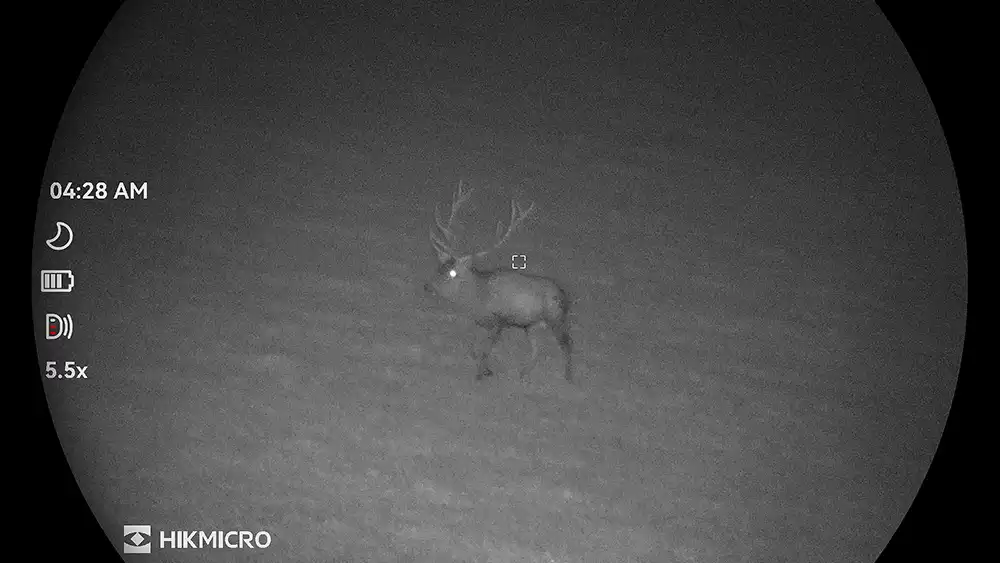Eyes in the Night: The HIKMICRO Habrok HQ50LN in Field Test
- Hans ARC
- Oct 22
- 4 min read

When it comes to modern optics, hunters today are witnessing a revolution.
Where once glassmakers battled physics to squeeze every last lumen of twilight through precision-coated lenses, the race has now shifted toward multispectral technology—combining thermal imaging, digital optics, and laser rangefinding in one rugged unit.
One of the most talked-about examples of this new generation is the HIKMICRO Habrok HQ50LN. Built for stalks, sits, and nighttime scouting alike, this flagship model promises a clear view—whether under blazing sun, thick fog, or total darkness. Schuss & Stille put it through its paces in the Austrian highlands, testing it not in theory, but where it counts: in the field.

Built for Rough Country
The first thing you notice about the Habrok HQ50LN is its heft.
At nearly a kilo (about 2.2 pounds), it feels substantial—rubberized, sealed to IP67 standards, and clearly designed for real-world hunting, not the showroom shelf.
This isn’t a fragile gadget. It’s a tool for long nights in the rain, when fog drapes the mountains and you’re waiting for movement at the treeline.
Image Quality and Field Performance
The Positives
Sharp contrast and detail: In thermal mode, the HQ50LN displayed crisp silhouettes up to roughly 300 meters. Limbs, vegetation breaks, and animal outlines were cleanly separated—an impressive feat in mixed cover.
Smart processing: HIKMICRO’s new Image Pro 2.0 algorithm genuinely improves the picture, reducing digital noise and enhancing fine detail—especially noticeable at mid-zoom.
Weather resistance: Fog, drizzle, or mist might dull visibility, but the device itself shrugged off the elements. IP67 sealing means dust and splash protection you can count on.
Room for Improvement
Zoom trade-offs: Push digital magnification to the limit and you’ll lose sharpness and contrast—an unavoidable side effect of digital zoom.
Firmware quirks: Some users report that certain units show slightly less thermal clarity than previous Habrok generations (like the HQ35L), with minor haloing or edge blur.
Weight and fatigue: That solid build comes at a price. After an hour of steady scanning, your arms will feel it. Dedicated stalkers may prefer a lighter optic for all-day hunts.
Battery life: The claimed seven hours of runtime is optimistic. In real-world use—laser rangefinder active, mode-switching, frequent scanning—expect closer to 4.5 to 5 hours. Bring a spare battery or two.
Thermal Vision in Low Light
Twilight is where thermal truly shines.
Long before the naked eye can pick out shape from shadow, the HQ50LN reveals glowing forms at the forest edge—red deer grazing unseen by conventional optics.
Through the Habrok’s viewfinder, they appear not as vague motion, but as living heat, each body a signature of life against the fading cool of dusk.

Owning the Darkness
On moonless nights, the Habrok comes into its own.
Targets out to 200–300 meters are identifiable, and motion pops instantly from the background. The integrated laser rangefinder is a welcome feature: one press, and the exact distance appears in the digital view—no guesswork, no fumbling for a separate device.
The 640×512 thermal sensor and image optimization deliver impressive clarity, even through fog or drizzle. Still, digital zoom softens the image, and power drain remains a limiting factor for marathon hunts.
An Encounter to Remember
One night during testing, the Habrok turned an ordinary stalk into something unforgettable.
We were crouched at the dark edge of a meadow, where forest melts into pasture. To the naked eye, nothing stirred.
Then—on the Habrok’s display—a herd of red deer ignited against the cool backdrop.
A heavy stag stood apart, every breath visible, his antlers etched in heat.
We dropped low, hearts pounding, as he moved closer. Step by step. Until barely five meters separated us. For a moment, time froze. Only the silent glow of the screen connected us—unseen, yet utterly present in that wild, electric stillness.
Clarity Beyond Darkness
Even in daylight, the Habrok’s hybrid design has its advantages.
In the mountains, where slopes roll endlessly and game blends seamlessly with rock and grass, thermal imaging quickly reveals where animals bed or feed—long before a glass scan might catch movement. Paired with binocular observation, it allows a careful, ethical approach.
It’s like seeing the mountain with new eyes—clearer, more honest, and more respectful of the wildlife whose world we step into.

Handling and Ergonomics
The Habrok allows independent focus adjustment for both thermal and digital channels—done through the eyepieces.
It works well, but for older hunters or those accustomed to traditional glass, brands like Nocpix may offer a more intuitive, binocular-like focusing system.

The Habrok Family at a Glance
The Habrok line includes several models to fit different budgets and hunting styles:
Habrok HE25L/LN: Compact 25mm thermal lens with 4K digital channel — ideal for day/night stalking. Around €1,500–2,000.
Habrok HQ35L/LN: Upgraded 35mm thermal module (640×512 sensor) and 4K optics — a balanced all-rounder around €3,250–3,300.
Habrok HQ50L/LN: The flagship model tested here, with a 50mm thermal lens and 4K digital channel — €3,700–4,200 range.
Habrok HX60L/LN: Top-tier powerhouse featuring a 1280×1024 sensor and 60mm optics — among the most advanced on the market, roughly €6,000.
Who It's For

Multispectral binoculars like the Habrok series are steadily replacing traditional optics among serious hunters.
They combine daylight magnification, night vision, thermal detection, and rangefinding—all in one unit.
They’re not toys. They’re precision tools for hunters who take responsibility seriously—those who want to act confidently even when the human eye fails.
The Habrok HQ50LN brings clarity to the night, insight to the day, and helps preserve the reverence that defines real hunting.
Whether you’re a backcountry stalker, a stand hunter, or a professional guide, there’s a Habrok built for your terrain—and your hunting style.
Available through select dealers and at Waffendoc Gregor Unterberger, Paternion, Carinthia (Austria).






Comments